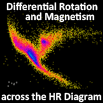Speaker
Ludovic Petitdemange
(MAG(CNRS/ENS/IPGP), LRA, Ecole Normale Supérieure, Paris)
Description
Magnetic fields of low-mass stars and planets are thought to
originate from
self-excited dynamo action in their convective interiors.
Observations reveal a huge
variety of stellar and planetary magnetic fields that differ in their
field strength
and topologies. We try to better understand the conditions
responsible for this
diversity by means of numerical dynamo simulations. In a
previous study
(Schrinner,Petitdemange, and Dormy 2012) we investigated more
than 70
three-dimensional, self-consistent dynamo models obtained by
direct numerical
simulations using the Boussinesq approximation. The control
parameters, the aspect
ratio and the mechanical boundary conditions were varied to
build up this sample of
models. Both, strongly
dipolar and multipolar models were obtained. We showed that
these dynamo regimes can
be distinguished by the ratio of a typical convective length-scale
and the Rossby
radius. Models with a predominantly dipolar magnetic field were
obtained, if the
convective length scale was at least an order of magnitude larger
than the Rossby
radius. Moreover, we highlighted the role of the strong shear
associated with the
geostrophic zonal flow for models with stress-free boundary
conditions. In this case,
the above transition disappeared and was replaced by a region
of bistability for
which dipolar and multipolar dynamos co-exist. We pointed out
that the nature of the
mechanical boundary conditions has only a minor influence on the
scaling law for the
magnitude of the magnetic field. Solving now the anelastic
equations using a new
version of the PaRoDy code, we follow these lines of research
and examine the
magnitude and the topology of the magnetic field in models with
some density
stratification. Furthermore, we discuss how these findings relate
to our previous
models and to observations.
Authors
Emmanuel Dormy
(MAG(CNRS/ENS/IPGP), LRA, Ecole Normale Supérieure, Paris)
Ludovic Petitdemange
(MAG(CNRS/ENS/IPGP), LRA, Ecole Normale Supérieure, Paris)
Martin Schrinner
(MAG(CNRS/ENS/IPGP), LRA, Ecole Normale Supérieure, Paris)
Roger Reynaud
(Institut d'Electronique Fondamentale Université Paris)

